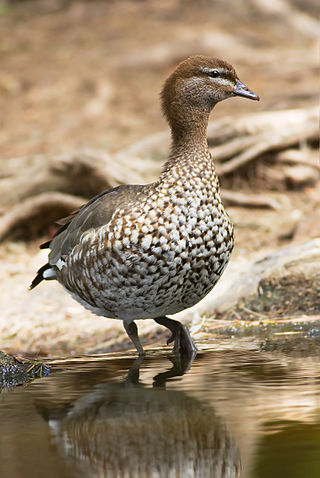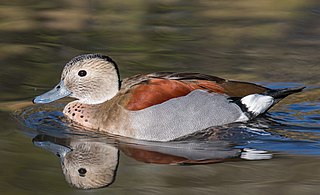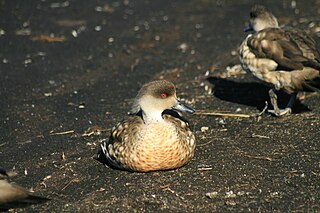
The Anatidae are the biological family of water birds that includes ducks, geese, and swans. The family has a cosmopolitan distribution, occurring on all the world's continents except Antarctica. These birds are adapted for swimming, floating on the water surface, and, in some cases, diving in at least shallow water. The family contains around 174 species in 43 genera.

The Anatinae are a subfamily of the family Anatidae. Its surviving members are the dabbling ducks, which feed mainly at the surface rather than by diving. The other members of the Anatinae are the extinct moa-nalo, a young but highly apomorphic lineage derived from the dabbling ducks.

The Tadorninae is the shelduck-sheldgoose subfamily of the Anatidae, the biological family that includes the ducks and most duck-like waterfowl such as the geese and swans.

The gadwall is a common and widespread dabbling duck in the family Anatidae.
The term perching ducks is used colloquially to mean any species of ducks distinguished by their readiness to perch high in trees.

The green-winged teal or American teal is a common and widespread duck that breeds in the northern areas of North America except on the Aleutian Islands. It was considered conspecific with the Eurasian teal for some time, but the two have since been split into separate species. The American Ornithological Society continues to debate this determination; however, nearly all other authorities consider it distinct based on behavioral, morphological, and molecular evidence. The scientific name is from Latin Anas, "duck" and carolinensis, "of Carolina".

The wood duck or Carolina duck is a partially migratory species of perching duck found in North America. The male is one of the most colorful North American waterfowls.

The mandarin duck is a perching duck species native to the East Palearctic. It is sexually dimorphic - the males are elaborately coloured, while the females have more subdued colors. It is a medium-sized duck, at 41–49 cm (16–19 in) long with a 65–75 cm (26–30 in) wingspan. It is closely related to the North American wood duck, the only other member of the genus Aix. 'Aix' is an Ancient Greek word which was used by Aristotle to refer to an unknown diving bird, and 'galericulata' is the Latin for a wig, derived from galerum, a cap or bonnet. Outside of its native range, the mandarin duck has a large introduced population in the British Isles and Western Europe, with additional smaller introductions in North America.

The Australian shelduck, also known as the chestnut-breasted shelduck or mountain duck, is a shelduck, a group of large goose-like ducks part of the bird family Anatidae. The genus name Tadorna comes from Celtic roots and means "pied waterfowl". They have a striking chestnut-coloured breast and black body. They are protected under the National Parks and Wildlife Act 1974.

The ferruginous duck, also known as ferruginous pochard, common white-eye or white-eyed pochard, is a medium-sized diving duck from Eurosiberia. The scientific name is derived from the Ancient Greek word, αἴθυιᾰ, an unknown seabird mentioned by authors including Hesychius and Aristotle, and the Russian word, нырок, the Russian word for pochard, which occurs in the bird's Russian common name.

The knob-billed duck or African comb duck is a type of duck found along the tropical/sub-tropical wetlands and waterways of Sub-Saharan Africa and the island of Madagascar, as well as most of South Asia and mainland Indochina.

The comb duck or American comb duck, is an unusual duck, found in tropical wetlands in continental South America south to the Paraguay River region in eastern Paraguay, southeastern Brazil and extreme northeastern Argentina, and as a vagrant on Trinidad.

The crested shelduck, or Korean crested shelduck, is a species of bird in the family Anatidae. It is critically endangered. The male crested shelduck has a greenish-black crown, breast, primaries, and tail, while the rest of its face, chin, and throat are brownish black. The male's belly, undertail coverts, and flanks are a dark grey with black striations. The upper wing coverts are white, while its speculum is an iridescent green. The female has a white eye ring, black crest, white face, chin, throat, neck, and uppers wing coverts and a dark brown body with white striations. Additionally, both sexes have a distinctive green tuft of feathers protruding from the head.

The falcated duck or falcated teal is a gadwall-sized dabbling duck from the east Palearctic.

The Australian wood duck, maned duck or maned goose is a dabbling duck found throughout much of Australia. It is the only living species in the genus Chenonetta. Traditionally placed in the subfamily Anatinae, it might belong to the subfamily Tadorninae (shelducks); the ringed teal may be its closest living relative.

The blue-winged goose is a waterfowl species which is endemic to Ethiopia. It is the only member of the genus Cyanochen.

The blue duck or whio is a member of the duck, goose and swan family Anatidae endemic to New Zealand. It is the only member of the genus Hymenolaimus. Its exact taxonomic status is still unresolved, but it appears to be most closely related to the tribe Anatini, the dabbling ducks.

The white-winged duck or white-winged wood duck is a large species of duck, formerly placed in the genus Cairina with the Muscovy duck and allied with the dabbling ducks. However, mtDNA cytochrome b and NADH dehydrogenase subunit 2 sequence analysis indicate that the anatomical similarity to the Muscovy duck is deceiving and that the species is appropriately placed in a monotypic genus, as Asarcornis scutulata, which is evolutionarily closer to the redhead.

The ringed teal is a small duck of South American forests. It is the only species of the genus Callonetta. Usually placed with the dabbling ducks (Anatinae), this species may actually be closer to shelducks and belong in the subfamily Tadorninae; its closest relative is possibly the maned duck.

The crested duck or South American crested duck is a species of duck native to South America, belonging to the monotypic genus Lophonetta. It is sometimes included in Anas, but it belongs to a South American clade that diverged early in dabbling duck evolution. There are two subspecies: L. specularioides alticola and L. specularioides specularioides. The Patagonian crested duck is also called the southern crested duck and its range lies in the Falklands, Chile, and Argentina.


























